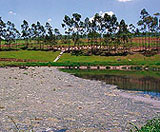
South American countries have an enormous need of well functioning wastewater purification systems, particularly in the densely populated regions, in view of the environmental problems. The statutory framework is in many cases already in place, but the implementation is missing, which in the majority of cases founders at financial hurdles. Consequently, at the present time, just 10 percent of wastewater in the major South-American cities goes for treatment. This results in massive enormous pollution of lakes and rivers, and limitations on water supply (Fig. 1). As an alternative to large, expensive, centralized treatment plants, decentralized solutions are being considered in many cases.
 Fraunhofer Institute for Interfacial Engineering and Biotechnology IGB
Fraunhofer Institute for Interfacial Engineering and Biotechnology IGB